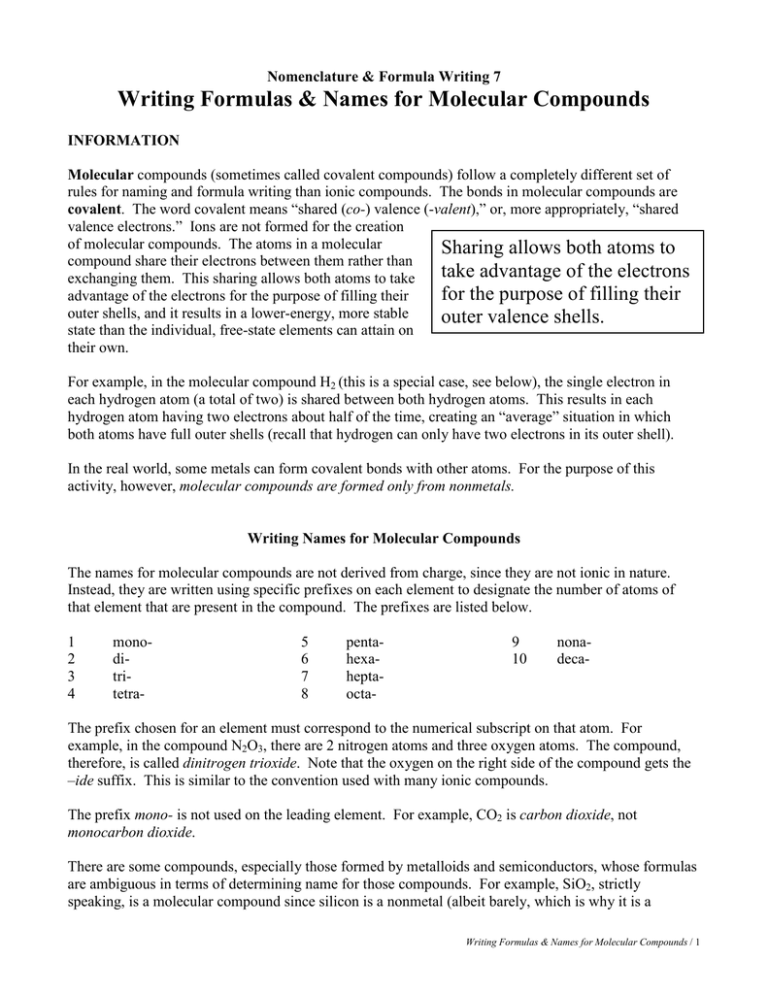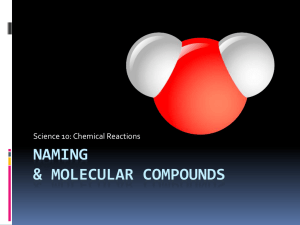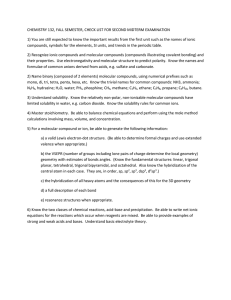Writing Formulas & Names for Molecular Compounds
advertisement

Nomenclature & Formula Writing 7 Writing Formulas & Names for Molecular Compounds INFORMATION Molecular compounds (sometimes called covalent compounds) follow a completely different set of rules for naming and formula writing than ionic compounds. The bonds in molecular compounds are covalent. The word covalent means “shared (co-) valence (-valent),” or, more appropriately, “shared valence electrons.” Ions are not formed for the creation of molecular compounds. The atoms in a molecular Sharing allows both atoms to compound share their electrons between them rather than take advantage of the electrons exchanging them. This sharing allows both atoms to take for the purpose of filling their advantage of the electrons for the purpose of filling their outer shells, and it results in a lower-energy, more stable outer valence shells. state than the individual, free-state elements can attain on their own. For example, in the molecular compound H2 (this is a special case, see below), the single electron in each hydrogen atom (a total of two) is shared between both hydrogen atoms. This results in each hydrogen atom having two electrons about half of the time, creating an “average” situation in which both atoms have full outer shells (recall that hydrogen can only have two electrons in its outer shell). In the real world, some metals can form covalent bonds with other atoms. For the purpose of this activity, however, molecular compounds are formed only from nonmetals. Writing Names for Molecular Compounds The names for molecular compounds are not derived from charge, since they are not ionic in nature. Instead, they are written using specific prefixes on each element to designate the number of atoms of that element that are present in the compound. The prefixes are listed below. 1 2 3 4 monoditritetra- 5 6 7 8 pentahexaheptaocta- 9 10 nonadeca- The prefix chosen for an element must correspond to the numerical subscript on that atom. For example, in the compound N2O3, there are 2 nitrogen atoms and three oxygen atoms. The compound, therefore, is called dinitrogen trioxide. Note that the oxygen on the right side of the compound gets the –ide suffix. This is similar to the convention used with many ionic compounds. The prefix mono- is not used on the leading element. For example, CO2 is carbon dioxide, not monocarbon dioxide. There are some compounds, especially those formed by metalloids and semiconductors, whose formulas are ambiguous in terms of determining name for those compounds. For example, SiO2, strictly speaking, is a molecular compound since silicon is a nonmetal (albeit barely, which is why it is a Writing Formulas & Names for Molecular Compounds / 1 metalloid). The name of this compound is silicon dioxide. Germanium, however, which is also a metalloid (again, barely a metal), when bonded with oxygen is sometimes referred to as germanium dioxide, while its ionic name is actually germanium oxide. In these cases, use the most logical convention – if both atoms are nonmetals, use their molecular name. If there is a metal involved, use the ionic name. Writing Formulas for Molecular Compounds Writing formulas for molecular compounds is the reverse of the naming procedure. The subscript for each element must correspond to the prefix. Remember that the absence of a prefix on the leading element is an understood “mono-” which indicates that there is only one atom of that element present in the compound. Unlike in ionic compounds, subscripts that share a common factor do not get reduced. For example, As4O10 does not simplify to As2O5. HONClBrIF, P4, S8 The seven elements hydrogen, oxygen, nitrogen, chlorine, bromine, iodine, and fluorine always form diatomic (2 atoms) molecular compounds with themselves when they are in their free state (elemental, unbonded) forms. However, they do not follow the naming convention for other “two-element” molecular compounds – they are simply named as the element they are. H2, O2, N2, Cl2, Br2, I2, and F2 are the forms that these seven elements take when they are not bonded with other elements, and are name, respectively, hydrogen, oxygen, nitrogen, chlorine, bromine, iodine, and fluorine. At standard temperature and pressure, all of these elements are gases, except for bromine, which is a liquid. Also, when in their free-state forms, phosphorus sometimes forms P4 molecules (known as white phosphorus), and sulfur forms S8 molecules. These are both solids at standard temperature and pressure (STP, 273K and 1 atm). Key Questions 1. Explain why molecualr compounds do not use charges to determine formulas in the same manner as ionic compounds. 2. In grammatically correct English, write detailed procedures for a) writing molecular formulas and b) naming molecular compounds. Assume that the procedures will be used by someone who has no prior knowledge of this material. Writing Formulas & Names for Molecular Compounds / 2 Student Name: ____________________________________________ Pd. ______ Date: ____________ Supplementary Exercises Molecular Compound Naming and Formula Writing Write the correct name for the following compounds. 1. KrF2 11. NI3 21. CO2 2. BrCl5 12. SF6 22. SO3 3. SCl4 13. XeF4 23. XeF6 4. PF3 14. PCl3 24. ICl2 5. CO 15. P2O5 25. SO2 6. PCl5 16. S2Cl2 26. P4O10 7. As4O10 17. ClO2 27. SF6 8. BrO3 18. SiO2 28. OF2 9. BN 19. BF3 29. XeO3 10. N2O3 20. N2S5 30. AsO4 Write the correct formula for the following compounds. 1. sulfur tetrachloride 17. sulfur trioxide 2. xenon trioxide 18. dinitrogen trioxide 3. carbon dioxide 19. phosphorus trichloride 4. diphosphorous pentoxide 20. carbon monoxide 5. phosphorous trichloride 21. boron monophosphide 6. sulfur dioxide 22. dinitrogen monoxide 7. bromine pentafluoride 23. nitrogen trifluoride 8. disulfur dichloride 24. dinitrogen monoxide 9. chlorine monoxide 25. xenon hexafluoride 10. oxygen difluoride 26. sulfur hexafluoride 11. boron trichloride 27. phosphorous pentachloride 12. dinitrogen pentasulfide 28. nitrogen monoxide 13. silicon tetrachloride 29. boron trifluoride 14. krypton difluoride 30. tetraarsenic decoxide 15. chlorine monoiodide 16. silicon dioxide Writing Formulas & Names for Molecular Compounds / 3





